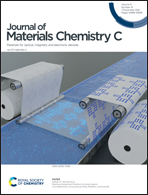Electrically adjusted deep-ultraviolet/near-infrared single-band/dual-band imaging photodetectors based on Cs3Cu2I5/PdTe2/Ge multiheterostructures†
Abstract
Multispectral photodetection has garnered enormous research interest and has always been challenging to date. Here, we present the realization of an electrically adjusted single-band/dual-band photodetector based on an inorganic lead-free halide Cs3Cu2I5/two-dimensional (2D) PdTe2 multilayer/Ge multiheterostructure. Owing to its unique optical property and distinct carrier transport behaviour, the device can be easily converted from a single-band photodetector operating in the near-infrared (NIR) region to a dual-band photodetector working in both deep-ultraviolet (DUV) and NIR regimes, upon applying a reverse bias voltage. Significantly, the device shows a peak responsivity of ∼694.1 mA W−1 at 1550 nm at zero bias, and maximum responsivity values of ∼744.2 mA W−1 and ∼712.5 mA W−1 at 265 nm and 1550 nm, respectively, at a small reverse bias. This characteristic also endows the photodetector with an excellent DUV/NIR dual-band optical imaging capability. This work will offer a new opportunity for designing high-performance photodetectors with multiple functionalities operating in complicated circumstances.



 Please wait while we load your content...
Please wait while we load your content...